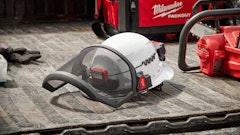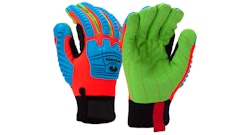
Although construction is physical work, the most important tool for workers, respectively, is their brain. To prioritize the safety of all the boots on the ground, it’s critical to evaluate the available head protection for industrial workers and potentially invest in a helmet that will allow workers to go back home to their families safely while maintaining the quality of life they desire.
 According to the U.S. Bureau of Labor Statistics, in 2020, the number of incidents for nonfatal falls, slips or trips was higher with construction workers compared to all other industry workers.STUDSON
According to the U.S. Bureau of Labor Statistics, in 2020, the number of incidents for nonfatal falls, slips or trips was higher with construction workers compared to all other industry workers.STUDSON
Nonetheless, industrial tradespeople have been wearing a traditional hard hat, the safety norm for more than the last 100 years, even though it can only protect from falling objects. With cases of incidents relating to falls, trips and slips greatly surpassing those from falling objects, it’s time for workers and safety directors to reconsider the personal protective equipment (PPE) mandated for the job.
Transitioning to Type II
Behind transportation incidents and COVID-19, falls represent the third deadliest risk in the construction industry. According to the Occupational Safety and Health Administration (OSHA), 1,008 fatal falls were documented in the U.S. construction industry in 2020. This accounts for nearly 35% of all construction-related incidents. The numbers are no surprise, considering more than half of the construction workforce operates on scaffolds. Working at heights alone significantly increases the risk of falls and associated potential for traumatic brain injuries.
In response, plant operators, construction safety officers and more are considering a new approach to head protection—Type II safety. An American National Standard for Industrial Head Protection (ANSI) Z89.1 Type II safety helmet can provide 360-degree head protection to defend against the many hazards on the jobsite. These helmets feature front, side, and rear impact protection; chin straps; and other integrated technologies to keep the helmet in place and offer better incident protection.
Safety features found in a Type II safety helmet include:
- Full brims and modular rear brims: Newer safety helmets now feature the traditional full-brim form factor that the industry knows and loves. Not only is it familiar, but it also provides better protection from outdoor conditions, including redirecting rainfall away from the head and neck and protecting from sun exposure. Other helmets may feature a slight rear brim that also deflects rain to an extent. However, seasoned construction workers, especially those working across civil jobs from road building to excavation, favor a full-brim helmet over a climbing-style helmet.
- Impact protection: Type II helmets often incorporate advanced impact protection technologies across the entire helmet, including features like Koroyd's welded-tube polymers. These polymer tubes are designed to crumple instantly upon impact, effectively absorbing maximum force. The mechanism provides comprehensive protection for the skull and brain, mitigating the risks associated with both direct and angled impacts. The reduction of oblique and angled impact forces is particularly crucial because these types of impacts are more likely to cause rotational shifts of the brain within the skull, which are associated with more severe forms of brain trauma. In doing so, Type II helmets play a critical role in minimizing the potential for life-changing or life-threatening injuries.
- Identification technology: Certain helmets feature embedded chips that use near-field communication (NFC) technology. These chips store essential emergency contacts and medical information, allowing swift access for first responders. For instance, Twiceme uses NFC, enabling first responders to scan the helmet's stored data using a mobile device. In contrast, conventional hard hats may necessitate workers to attach health information on paper inside the helmet. This approach can pose challenges for medical professionals during the initial assessment because they may be unable to remove the helmet without risking further injury.
 The four-point chin strap system ensures a secure fit and prevents the helmet from dislodging in the event of a fall.STUDSON
The four-point chin strap system ensures a secure fit and prevents the helmet from dislodging in the event of a fall.STUDSON - Four-point chin strap systems: Safety helmets in action sports, such as those used for biking and rock climbing, often come equipped with buckle enclosures and adjustable, nylon, four-point chin straps. These features have now been incorporated into industrial safety helmets to provide construction workers with maximum adjustability and allow for easy one-handed use, even when wearing gloves. The presence of chin straps not only ensures a secure fit but also prevents the helmet from dislodging in the event of a fall, setting these apart from traditional strapless hard hats.
- Replaceable pad sets: While Type II safety helmets already incorporate impact protection, traditional padding is also found throughout to ensure a comfortable fit. Some helmets feature replaceable pad sets that improve safety, comfort and hygiene. While not the most glamorous feature, its washability offers a cleaner and more hygienic experience for the wearer.
Protecting Workers from Injury
While falls, trips and slips rank among the leading causes of serious injuries and fatalities, these incidents are preventable. Organizations can enhance workforce safety by implementing OSHA's recommendations, notably from its recent "Fall Protection Campaign," and by investing in improved PPE, such as Type II safety helmets.
According to the Bureau of Labor Statistics, the majority of head injuries resulting from slips, trips and falls occur within a distance of 6 feet or less. This underscores the significance of many commercial general contractors now requiring Type II safety helmets with chin straps with additional certifications to ensure compliance on high-profile jobsites. Beyond fall protection, comfort, and advanced crumple technology, Type II safety helmets offer other advantages when compared traditional hardhats:
- Extended lifespan: Thoughtful, ruggedized designs contribute to longer safety-helmet lifetimes, reducing the need for frequent PPE turnover.
- Comprehensive protection: Front, side and rear impact safety features with chin straps lower the overall risk of workplace injuries.
- Financial benefits: Fewer injuries translate to fewer worker compensation claims, leading to potential cost savings for organizations.
- Reduced liability insurance costs: A decrease in injuries may contribute to lower liability insurance expenses for businesses.
- Risk reduction: Implementing Type II safety helmets fosters a culture of safety on the jobsite, contributing to an overall reduction in workplace risks.
- Increased productivity: With fewer injuries, workers can spend more time on the jobsite and less time recovering, potentially boosting productivity and earnings.
Next Steps Toward Improved Safety
 OSHA has not yet changed regulations, they just announced that all jobsite inspectors will be wearing Type II helmets in the future.STUDSON
OSHA has not yet changed regulations, they just announced that all jobsite inspectors will be wearing Type II helmets in the future.STUDSON
It’s time for organizations and workers alike to recognize the need for such head protection and make moves to adopt it. Even though OSHA has not yet changed regulations, they just announced that all jobsite inspectors will be wearing Type II helmets in the future.































